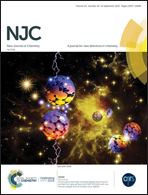Mechanisms of phosphine-catalyzed [3+3] cycloaddition of ynones and azomethine imines: a DFT study†
Abstract
To understand the mechanisms and origins of the stereoselectivity of a PPh3-catalyzed [3+3] cycloaddition reaction between a ynone and an azomethine imine, density functional theory (DFT) calculations have been conducted at the M062X/6-31G(d) level. Several possible reaction pathways have been investigated and analyzed, so as to identify the most preferred pathway. DFT results suggest that the catalytic cycle proceeds via six steps which involves addition of the phosphine catalyst to ynone, 1,3-proton transfer, nucleophilic addition to azomethine imine, intramolecular cycloaddition, 1,2-proton transfer and phosphine catalyst regeneration. The pathway leading to the Z-isomer product is found to be most energetically favorable. n-Butanol (n-BuOH) employed in the experiment plays an important role in both proton transfer steps. In the most preferred pathway, the presence of n-BuOH is found to lower the proton transfer energy barriers by 26.8 kcal mol−1 and 30.1 kcal mol−1, respectively, for the two proton transfer processes compared to its absence. Our computational results agree well with the experimental observations.
![Graphical abstract: Mechanisms of phosphine-catalyzed [3+3] cycloaddition of ynones and azomethine imines: a DFT study](/en/Image/Get?imageInfo.ImageType=GA&imageInfo.ImageIdentifier.ManuscriptID=C9NJ01943J&imageInfo.ImageIdentifier.Year=2019)


 Please wait while we load your content...
Please wait while we load your content...